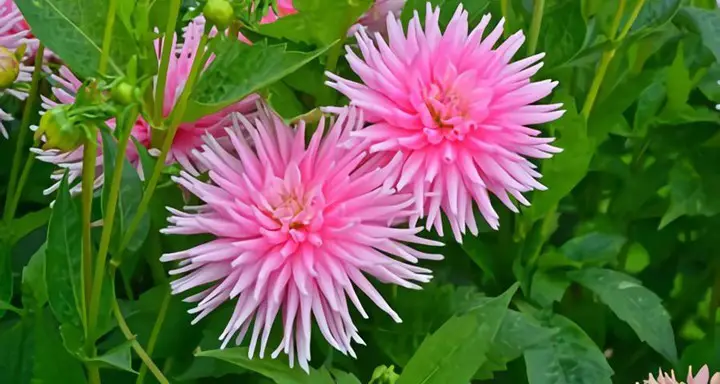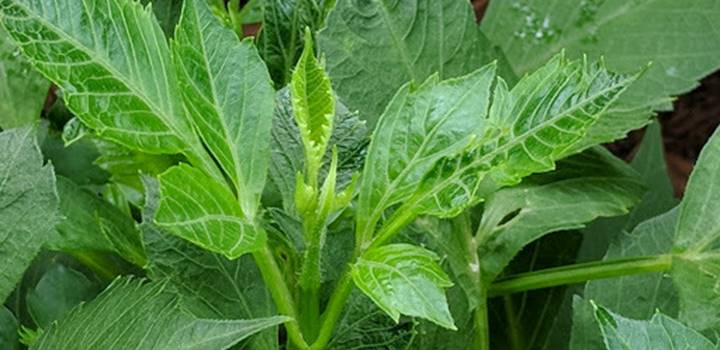Dahlias are surely a delight! Their majestic appearance can lure anyone into growing them. But they aren’t immune to diseases!
So if you are wondering “why are my dahlia leaves turning yellow?”
There are some issues like Nutrient deficiency, Soil problems, Pest attacks and, Fungal attacks that can be the causes why your Dahlia leaves are turning yellow.
Taking action as early as possible is the key to saving your Dahlias from yellowing. But identifying the actual problem is very crucial before starting any treatment. Don’t worry! I’ve got you covered.
This article will help you identify all the possible reasons and their solutions that will ease up your gardening activity.
Let’s get going –
Why Dahlia Leaves Are Turning Yellow?[Causes & Solutions]

1. Nutrient Deficiency
Nutrient deficiency is the most common reason for turning the leaves yellow. Nitrogen is directly related to chlorophyll production and iron is also necessary to make chlorophyll.
So in both cases, plants lack chlorophyll. This could be the reason behind making the leaves turning yellow and also shriveling up of Dahlia leaves.
Two types of deficiencies are common.
- Iron chlorosis
- Nitrogen chlorosis
Identification
You might be wondering how we can be certain which one is causing it? Here’s a clue:
Nitrogen-deficient Dahlia leaves will start turning yellow from the base of the leaf blade and the old leaves will be turning yellow first.
On the other hand, Iron-deficient leaves will turn yellow from the top of the leaf blade and new leaves will be turning yellow first.
Solution
- For iron chlorosis, you can use iron sulfate, iron chelate, aluminum sulfate, and Sulphur. You can spray iron chelate on your potted Dahlia. Let me suggest a good one for you (our pick: Southern Ag 01952 Chelated Liquid Iron)
- For Nitrogen deficiency, you can use urea or ammonium nitrate. Apply Nitrogen-Phosphorus-Potassium as you know as N-P-K in 5:10:10 ratio. (our pick- Miracle-Gro Water Soluble Bloom Booster Flower Food)
Prevention
- If you are growing Dahlia outdoors, You can grow beans or peas for a season in the soil. It can help fix Nitrogen deficiency.
- Remove weeds as much as possible and apply Organic materials like Farm-Yard-Manure, bone meal, and blood meal.
- Make sure there’s the availability of other nutrients because one deficiency inhibits the uptake of another.
- Avoid overdosing on Nitrogen. Dahlias prefer a bit less Nitrogen than usual.
2. Irregular Watering
Irregular watering is one of the most common reasons for the yellowing of leaves. But watering can be confusing. Wonder why? Surprisingly both over-watering and under-watering show the same signs! Both are the reason behind leaves turning yellow then brown and shriveling up.
Initially leaves start being yellow on the edges and eventually turn brown. Even excess water loss can even make the leaf curl up.
Identification
Dip your fingers near your yellowed Dahlia plant and take a pinch of soil. If it feels dry then it may be for under-watering and if it feels moist then it may be for over-watering. You can use the moisture meter for more accuracy. (Our pick: Atree Soil Soil Tester Kits with Moisture, Light, and PH Test for Garden)
Solution
- If the soil seems mushy or soggy, Don’t water until the soil dries out to normal.
- If the soil seems too dry especially during hot summers, water is just enough to keep the soil moist.
Prevention
- Water deep enough up to thrice a week depending on the weather conditions and keep the soil well-drained
- In the case of potted Dahlia, make sure of drainage holes in the pot.
- Use Organic matter to improve drainage and soil structure
3. Incorrect soil
Dahlias love soil around pH 6-6.5. So when the soil becomes alkaline Dahlia leaves start turning yellow. It’s important to keep the soil pH monitored because in high pH Nitrogen and Iron deficiency are more likely to occur.
Identification
It’s best to use a pH meter for accurate results (Our pick: Atree Soil Soil Tester Kits with Moisture, Light, and PH Test for Garden). You can also guess without a meter but it won’t tell you the severity.
- Mix 1 teaspoon soil sample, 1/4 cup water, and 1/4 cup white vinegar. If it produces bubbles then your soil is alkaline.
- Likewise, mix 1/4 cup baking soda, 1/4 cup of water into your soil sample. If there are bubbles the soil is acidic.
Solution
Aluminum sulfate and sulfur are the two most common things used to lower the pH. You can apply them to your garden soil and your potted Dahlias as well. Here’s a recommended lime fertilizer for you (our pick: Jobe’s Organics Garden Lime Soil Amendment)
4. Environmental Stress
Dahlias are pretty much tender plants. Too much exposure to sunlight at a high temperature is not good for plants. When strong windy weather meets with high temperature, plants lose moisture even faster and this can be the reason for Dahlia leaves turning yellow on the edges. 5-6 hours of morning sunlight is enough for Dahlias.
Solution
- You can use any cloth to cover the Dahlias to protect them from direct sunlight.
- Make sure your Dahlia gets sufficient water
- Use fertilizer only when new green leaves have started to grow.
Prevention
- Plant Dahlias in such placement around big trees or buildings so they can get sunlight in the morning and shade during the afternoon.
- Slowly introduce your potted Dahlias to the outer environment
5. Insect attack
Insects feed on plants and decrease nutrient levels. This is why leaves start turning yellow. Dahlias get attacked by many insects.
Potato Leafhoppers, Aphids, Thrips, Mealybugs, and spider mites are some major insects that attack Dahlia. Infestation of all these results in yellowing and shriveling up of the leaves. Sometimes leaves can turn both yellow and brown.
Identification
Check the lower surface of the leaves because that’s where they linger. Look out for movements in the plant. If you see webs on the leaves then it’s spider mites making your Dahlia leaves turn yellow.
Solution
- You can try insecticides containing Pyrethrins or Beauveria bassiana, a fungus that kills many kinds of pests. Our recommendation is- Southern Ag 10401 Natural Pyrethrin Concentrate
- In the case of spider mites use miticide that contains Bifenazate. Our suggestion is (Our pick: Compare-N-Save Concentrate Indoor and Outdoor Insect Control)
- If you want to go with organic control then Neem oil or organic insecticidal soap should be your pick. You can try this (our pick: Bonide Ready-to-Use Insect Soap)
- Sticky traps are one of the harmless ways to trap insects.
- You can rinse plants thoroughly with water
- Stop giving fertilizer until you get rid of them
You can also make insecticides and insect traps at home by following the steps below.
#Garlic spray
- Take 6-7 garlic cloves and 1 cup of water and blend them in a mixer-blender.
- Strain it so any garlic part won’t clog the nozzle of your sprayer
- Then add water to make it a 2-liter solution. You can store it in your fridge and spray it every week if there’s a pest attack.
#Insecticidal soap
- Combine 3 tablespoons liquid soap and 1 tablespoon of oil in 2-liters water.
- That’s it. Start spraying.
#Insect trap
- Take a wood or plastic piece. Paint it yellow because this color attracts insects.
- Put any sticky material like engine oil or petroleum jelly on it. Then set it near your plant.
- You can wash and re-use it whenever necessary by just applying the same sticky material.
Prevention
- Remove infected plants and dispose of them to prevent further infestation.
- Avoid excess fertilization of any nutrient.
- Don’t let the soil too dry because spider mites prefer dry conditions.
- You can use nets to cover Dahlias to minimize infestation.
6. Fungal Problem
Some fungal problems result in the yellowing of leaves including Root rot, Stem rot, Rotten tubers, and Verticillium Wilt.
Overwatering results in fungal growth and leads to root rot and stem rot and rotten tubers that make leaves turn yellow and then brown. In the case of stem rot, you might see your Dahlia leaves turning yellow and brown at the same time. Verticillium wilt is not that common but there’s no cure for it.
Solution
- Remove the infected plant or infected parts
- Disinfect garden tools with bleach
- You can get a fungicide for Dahlia that carries myclobutanil or thiophanate-methyl. You can try this (our pick: Spectracide Immunox Multi-Purpose Fungicide Spray Concentrate)
Or try these homemade fungicide recipes-
#Baking Soda Mixture
Mix 2 teaspoons baking soda,1 teaspoon soap,1 teaspoon oil in 2 liters of water and pour it into the sprayer. Apply in a small part first to check it’s not harming the plant.
#Neem Oil
Mix 3 teaspoons of neem oil in 2-liter water. Then pour it into the sprayer and spray when necessary.
Prevention
- Avoid over-watering and overfertilization
- Keep proper plant spacing
Conclusion
I’ve tried to make this article as resourceful as possible and I hope you found the reason why your Dahlia leaves are turning yellow with its solutions. If you find this article helpful, comment below and share it with your friends. Happy growing!
